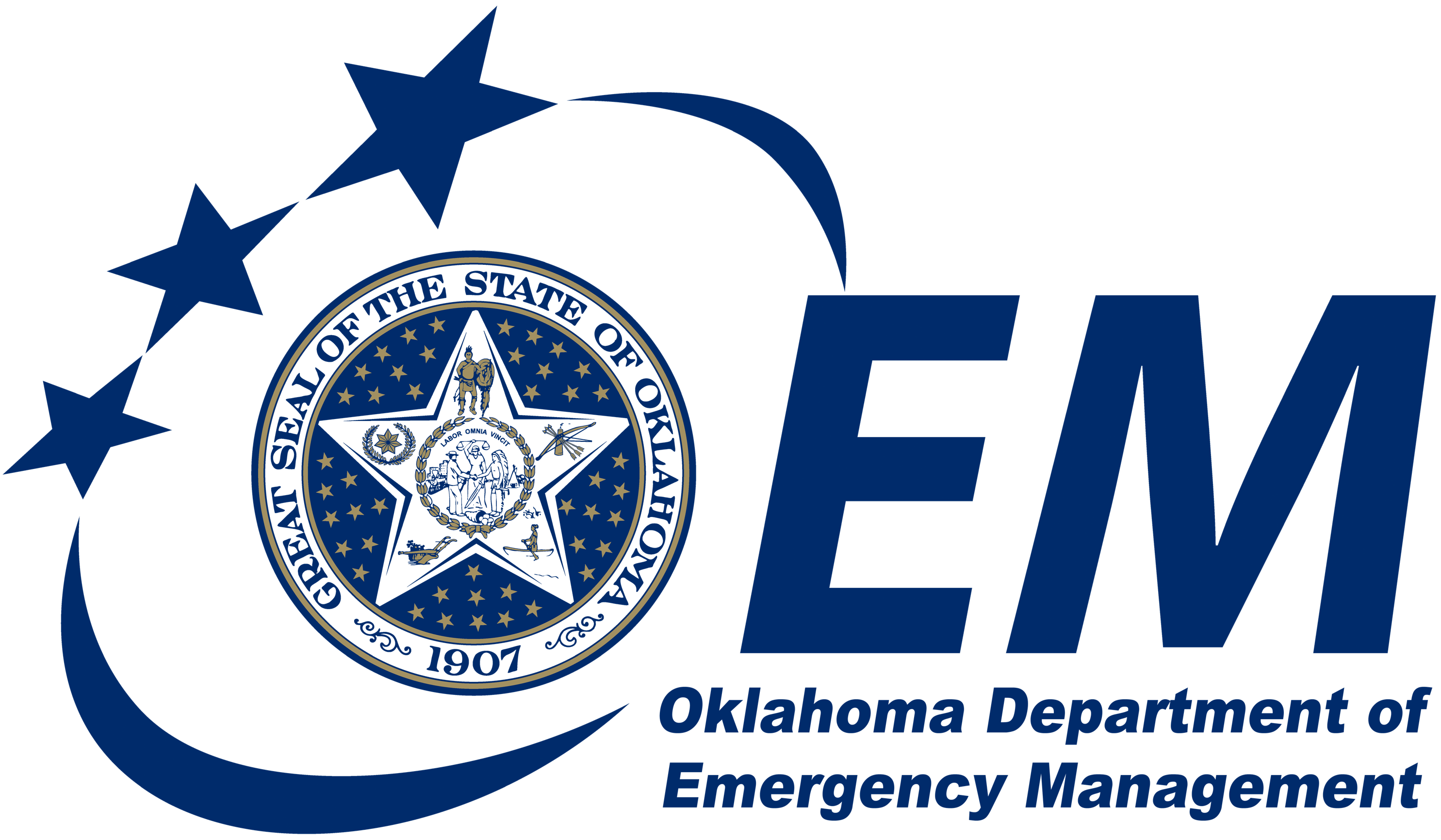WINTER STORM IMPACTS STATE
Situation Update
Oklahoma Department of Emergency Management
Situation Update 3
December 6, 2013, 12 p.m.
Due to the latest winter storm impacting Oklahoma, the State Emergency Operations Center (EOC) remains activated. Agencies and organizations represented at the State EOC during activation have included the Oklahoma Highway Patrol, Oklahoma Department of Transportation, Oklahoma National Guard, Oklahoma State Department of Health, Oklahoma Office of Homeland Security, Salvation Army, American Red Cross and other disaster relief agencies.
Roads are slick and hazardous in many areas of the state. Numerous schools and businesses are closed. State agency nonessential services are also closed today. Stay tuned to local media for notification of cancelations.
STATE OF EMERGENCY
A State of Emergency for all 77 Oklahoma counties remains in place. On Thursday, Governor Mary Fallin issued the declaration due to the winter storm. The Executive Order allows state agencies to make emergency purchases related to disaster relief and preparedness. It is also a first step toward seeking federal assistance should it be necessary.
MASS CARE
The American Red Cross has opened a warming center in Hugo at First Baptist Church, 300 E. Jackson Street. This center may transition to a shelter if needed.
Baptist Disaster Relief is moving a feeding kitchen to Hugo as well.
The American Red Cross, The Salvation Army and Baptist Disaster Relief remain on standby to assist with shelters, warming stations and feeding stations in other impacted areas.
FATALITIES AND INJURIES
Oklahoma Highway Patrol reports one weather related fatality has been confirmed in Muskogee.
According to the Oklahoma State Department of Health, 116 storm related injuries have been reported by area hospitals including 48 falls.
The Oklahoma Highway Patrol has responded to 106 weather-related collisions since 8 a.m. Thursday. They continue to urge motorists to avoid travel in the affected areas.
RESOURCE COORDINATION
Oklahoma Forestry Division is responding to Pushmataha and Choctaw counties with equipment to move fallen trees out of roadways. Baptist Disaster Relief is also deploying chainsaw teams to help with timber debris. This will help allow power restoration teams access to the area to assist with restoring power to homes and businesses.
In preparation for the storm, the State Emergency Operations Center is activated and the Oklahoma Department of Emergency Management (OEM) is working with local emergency managers across the state as well as numerous emergency response, recovery partners. OEM staff remain in the hardest hit areas of the state, assisting communities with local response, recovery efforts.
OEM, Oklahoma Highway Patrol, Oklahoma National Guard and Oklahoma Department of Transportation have developed a stranded motorist plan with teams positioned across the state in the areas with greatest risk for dangerous road conditions.
Additionally, OEM worked with FEMA to preposition industrial size generators in the state. The generators will be used in the event shelters are needed due to stranded motorists or power outages. The generators will also be used to provide power to water treatment plants in the event of electric service disruptions. The FEMA generators will augment the industrial size generators OEM already has positioned around the state. Please note these generators are NOT for residential use.
POWER OUTAGES
The Oklahoma Corporation Commission reports more than 9,000 homes and businesses are without power across the state -- most in southeast Oklahoma.
OG&E Total: 720
Cameron: 162
Heavener: 87
Hodgen: 93
West Oklahoma City: 61
Panama: 83
Poteau: 336
PSO Total: 3,851
Hugo area (includes Hugo, Antlers, Fort Towson, Sawyer): 3,780
Elk City: 71
Arkansas Valley Electric Total: 449
Pocola area: 41
Sweet Briar, Spiro areas: 408
Verdigris Valley Electric Total: 57
Claremore area: 56
Skiatook area: 1
Choctaw Electric Total: 4,000
ROAD CONDITIONS
As a winter precipitation continued overnight, crews from the Oklahoma Department of Transportation report slick and hazardous conditions on highways and interstates across the state. Plowing operations along with salt and sand treatments continue statewide. Motorists need to be extra cautious on entrance and exit ramps due to slick conditions and the speed differences as traffic is slowing to exit and speeding up to enter highways and interstates.
Roads throughout the state, including the Oklahoma City and Tulsa Metro Areas are snow packed and slick. Travel is highly discouraged at this time. Crews will continue to address these issues 24/7 until roads are clear and conditions are favorable.
To check CURRENT ROAD CONDITIONS, call the Department of Public Safety's ROAD CONDITIONS HOTLINE at 405-425-2385 or visit Oklahoma Road Conditions Map.
PRICE GOUGING
The Oklahoma Office of the Attorney General reports that Oklahoma’s Emergency Price Stabilization Act remains in effect for 77 Oklahoma counties due to the Governor’s State of Emergency. Attorney General Scott Pruitt said Oklahoma’s price gouging statute prohibits an increase of more than 10 percent in the price of most goods and services when a state of emergency has been declared.
DIAL 211
For Oklahoma residents seeking non-emergency disaster or health and human service information, please contact 2-1-1. Services are available 24 hours a day by dialing 2-1-1 from your home or cellular telephone. Please only call 911 for emergencies.
EXTREME COLD EXPOSURE SAFETY
With temperatures expected to remain below freezing in the coming days, the Oklahoma State Department of Health offers the following tips for extreme cold exposure safety.
Prolonged exposure to the cold can cause frostbite, hypothermia, or in extreme cases, death. Infants and the elderly are most susceptible to extreme cold. Frostbite occurs when the skin becomes cold enough to actually freeze. A loss of feeling and a white or pale appearance in extremities, such as fingers, toes, ear lobes, or the nose are symptoms of frostbite. Hypothermia (low body temperature) can occur during longer periods of exposure when the body temperature drops below 95 F. A person will become disoriented, confused, and shiver uncontrollably, eventually leading to drowsiness and apparent exhaustion. In severe cases, death is possible. The following tips can help decrease the risk of cold exposure:
- Wear layered clothing outdoors for better protection from the cold. Wear a cap to prevent rapid heat loss from an uncovered head. Cover exposed skin to prevent frostbite.
- While indoors, try to keep at least one room heated to 70 F. This is especially important for the elderly and small children to prevent hypothermia.
- Sleep warm with extra blankets, a warm cap, socks and layered clothing.
- Avoid fatigue and exhaustion during cold weather. Overexertion, such as shoveling snow or pushing a car, can strain your heart.
- Carry extra clothing, blankets and high energy snacks, such as cereal or candy bars in your car for protection if car stalls. Keep the gas tank near full to prevent icing. Don't travel alone.
- Check daily on elderly friends, relatives and neighbors who live alone.
- The elderly and very young should stay indoors as much as possible. Offer to shop for elderly friends and relatives. Just like in the summer with heat, it takes some time to get acclimated to cold weather.
###
Situation Updates are posted at www.oem.ok.gov
Follow us on Twitter @OKEM
Next Situation Update: As conditions warrant


